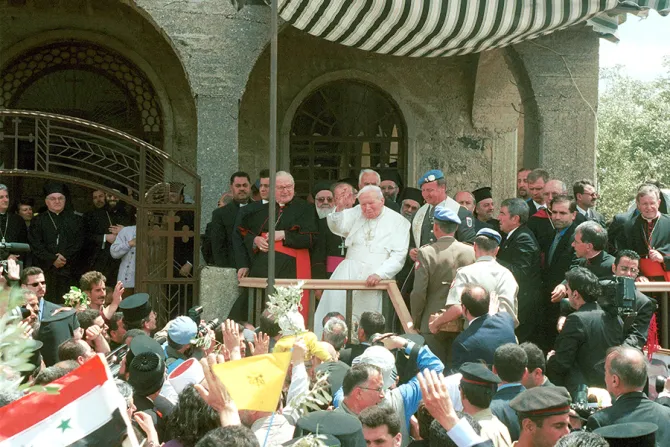Damascus, Syria, Apr 3, 2018 / 13:00 pm
When Pope Saint John Paul II visited Syria in 2001, he called on Christians to remember Syria's "magnificent contribution" to the history of Christianity. As the country reels from seven years of civil war, Christian communities in Damascus continue to struggle to protect that heritage.
"We remember that it was in fact in Syria that the Church of Christ discovered her truly catholic character and took on her universal mission. The Apostles Peter and Paul, each according to the grace received, worked here to gather together the one family of Christ, welcoming believers coming from different cultures and nations," said Pope John Paul II in Damascus on May 6, 2001.
Within the walls of the Damascus' Old City is the tomb of St. John the Baptist, the house where St. Ananias took in a blinded Saul, and the Gate of St. Thomas, known as Bab Touma, through which the apostle traveled on his way to evangelize India.
For John Paul II, it was primarily a pilgrimage in the footsteps of Saint Paul that brought him to Damascus. The pontiff spent three days in Syria in 2001 as a part of a six-day journey following Saint Paul's evangelizing missions in the Mediterranean, including stops in Greece and Malta.
"At the gates of Damascus, when he met the Risen Christ, Saint Paul learned this truth and made it the content of his preaching. The wonderful reality of the Cross of Christ, upon which the work of the world's Redemption was wrought, became present before him … Brothers and sisters, let us lift our eyes to the Cross of Christ to find the source of our hope!" proclaimed the pope during his trip.
The Holy Father also praised the great contributions of Syria's saints throughout history.
"From the very beginning of Christianity, flourishing communities were to be found here. In the Syrian desert Christian monasticism flourished; and the names of Syrians such as Saint Ephraem and Saint John Damascene are etched for ever in Christian memory. Some of my predecessors were born in this area."
One of the historic monasteries built in the fifth-century has been destroyed. St. Elias Monastery was bulldozed by the Islamic State in April 2016, during the jihadist group's genocide of Christians in Syria and Iraq.
Today, the reality of the cross is vivid for the remaining Christians in Syria, who have seen their communities drop by 75 percent in cities like Aleppo, once home to the country's largest Christian population.
On Easter, Pope Francis prayed for an end to the "carnage" in "the beloved and long-suffering land of Syria, whose people are worn down by an apparently endless war."
Catholics who remain in Damascus walked through the Old City's narrow streets on Holy Thursday to pray at seven historic churches, some of which had been damaged by mortar coming from the Eastern Ghouta suburb, only 12 kilometers away.
One of the churches visited during the Holy Week procession is the Syrian Orthodox Cathedral of Saint George, the same church in which St. John Paul II reflected ten years before the start of the Syrian civil war, "these will be the marks of our fidelity to God: to pray, to carry the Cross, to obey God's will and to honour everyone as a brother or sister."
John Paul II made history during his short visit in May 2001 by being the first pope to enter a mosque. The Umayyad Mosque was decorated with Vatican and Syrian flags for the occasion. In 715 AD, the mosque was built on top of a fourth-century Christian cathedral containing the head of John the Baptist, according to tradition.
The pope lamented that his short trip to Syria did not allow him to visit "all the Churches dedicated to the Mother of God in this great and noble city of Damascus."
"I would also have liked my pilgrimage in the footsteps of Saint Paul to have included a visit to some of the venerable Shrines of the Virgin Mother of God, such as those at nearby Seidnaya, or in Homs, Aleppo, Tartus and elsewhere. I have not forgotten that according to a pious tradition it was near Tartus that the Apostle Peter, on a journey from Jerusalem to Antioch along the Mediterranean coast, dedicated a chapel to the Virgin Mary, the first Marian shrine in Syria," continued the pontiff.
Homs and Aleppo, mentioned by the late pope, are among the cities most devastated by the Syrian conflict.
Between 5,000 to 13,000 people have been executed in the city of Seidnaya by Syrian President Bashar al-Assad's government during the conflict, according to Amnesty International. The 6th-century Seidnaya Monastery, containing a miraculous icon of the Theotokos, has also been damaged in the conflict.
(Story continues below)
The Syria encountered by Saint John Paul II in 2001, before the September 11th terrorist attacks, was vastly different from the war-torn Syria today, but Christians there still cling to words he spoke during his visit to the country:
"The joy of Easter flowered on the wood of the Cross … When God acts, the impossible becomes possible. It is our task to say 'yes' to God's saving will and to accept his mysterious plan with our whole being."



